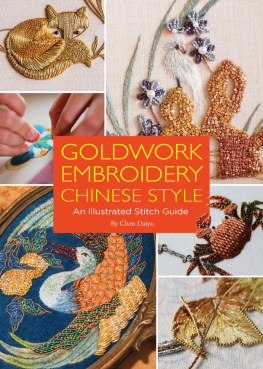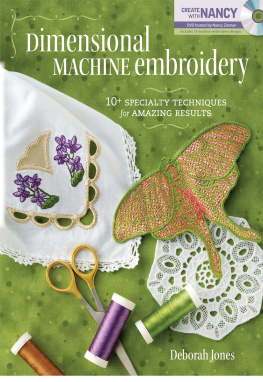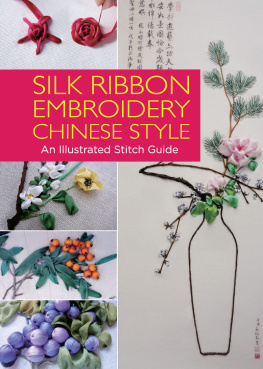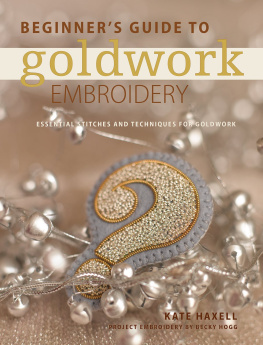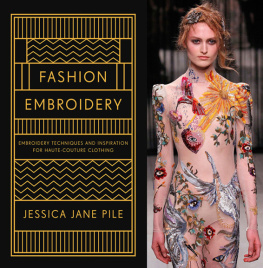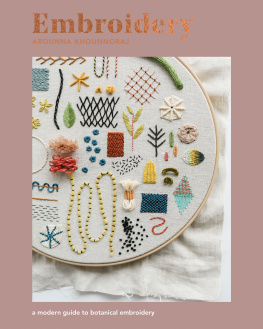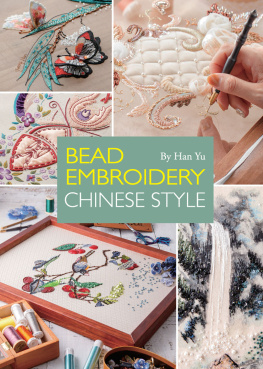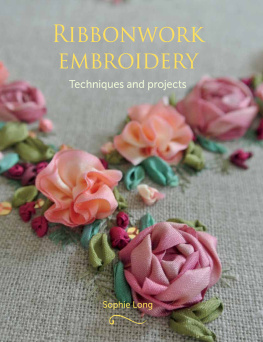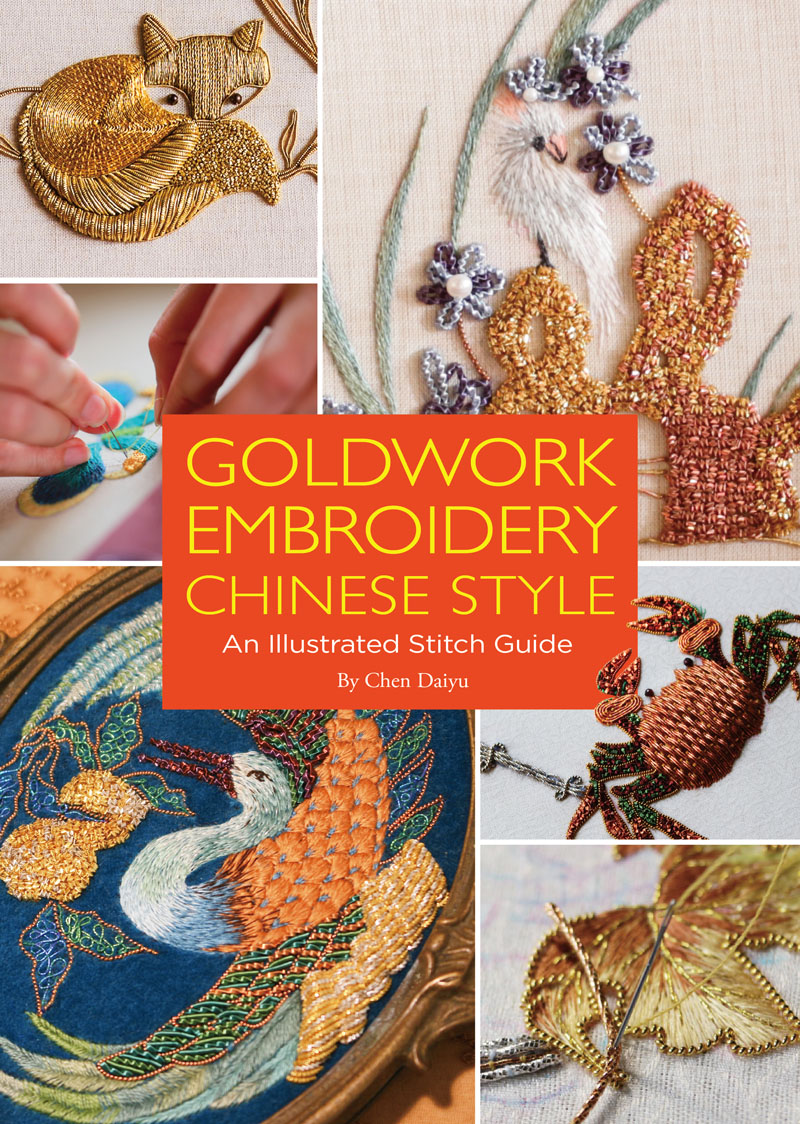

A Little Butterfly with Rounded Gold Wings
Main techniques and materials: long and short stitch (blue and green vintage linen thread), cutwork over felt (bright check), outline (pearl purl)
This piece of embroidery depicts a butterfly with rounded wings. It mainly involves two techniqueslong and short stitch, and cutwork. Butterflies often play a supporting role in the background of Chinese literati paintings. They are the embodiment of beauty, and the symbol of happiness and bliss. In this piece, however, the butterfly is the protagonist, allowing the audience to focus on its beauty.
On
A Blue, Green, and Silver Butterfly
Main techniques and materials: cutwork over felt (bright check), long and short stitch (DMC cotton thread), outline (pearl purl)
Traditional Chinese goldwork embroidery mainly involves gold and silver threads, and they are often matched with intense colors such as red and green. A Blue, Green, and Silver Butterfly has achieved a breakthrough in this regard, as its wings are mainly stitched using light teal ombre cotton thread and matched with green and silver bright check of the same color family. The edges are then outlined with silver pearl purl to create a huge, lively, and nimble butterfly.
Copyright 2022 Shanghai Press and Publishing Development Co., Ltd.
All rights reserved. Unauthorized reproduction, in any manner, is prohibited.
This book is edited and designed by the Editorial Committee of Cultural China series.
Text and Photographs: Chen Daiyu
Translation: Shelly Bryant
Cover Design: Wang Wei
Interior Design: Li Jing, Hu Bin (Yuan Yinchang Design Studio)
Editor: Cao Yue
Editorial Director: Zhang Yicong
ISBN: 978-1-93836-865-3
Address any comments about Goldwork Embroidery: Chinese Style to:
SCPG
401 Broadway, Ste. 1000
New York, NY 10013
USA
or
Shanghai Press and Publishing Development Co., Ltd.
390 Fuzhou Road, Shanghai, China (200001)
Email:
Printed in China by Shanghai Donnelley Printing Co., Ltd.
1 3 5 7 9 10 8 6 4 2

The Snail
Main techniques and materials: bricking (passing and twist), padding over cotton thread (smooth purl and rough purl)
Snails are very common, and are often depicted in ancient Chinese poems. They crawl very slowly but never give up, so they have become a symbol of endurance. In this piece, the snails shell is embroidered using the double-threaded bricking techniquethat is, pinning with two strands of metal thread at the same time. It is the same as only working with one strand, except double-stranded embroidery thread is used to fix the metal thread in place. Passing and twist are used alternatively on the snails head, while smooth purl and rough purl are used alternatively, to cover the snails tail, where the technique of padding over cotton thread is applied.
CONTENTS

Embroidered Goldwork Earrings
Main techniques and materials: beading (pearl), cutwork (rough purl)
Combining embroidery and silverwork is a way to incorporate embroidery into daily life. The surface of this pendant is embroidered using rough purl and pearl, while the silverwork is crafted from distressed sterling silver for a more rustic feel.

The Owl
Main techniques and materials: couching in a circle (Japanese gold), bricking (Japanese gold), cutwork over felt (bright check), chain stitch (wire check)
This piece is a breakthrough in traditional goldwork embroidery in terms of both subject matter and technique. Regarding the subject matter, owls rarely feature in Chinese paintings. Apart from traditional techniques such as bricking and couching in a circle, the stacking effect on the owls wings, the gold and copper Rococo used on its claws, and the chain stitch technique applied on the three-color wire check to create the fluffy feathers on its chest, all exemplify the variety of goldwork embroidery techniques that can be used in combination with different materials.

Embroidered Goldwork Earrings
Main techniques and materials: long and short stitch (silk thread), outline (pearl purl), beading (pearl, lapis lazuli gemstones)
Goldwork embroidery is attempting to find its way into our everyday lives through jewelry. To make embroidered jewelry more wearable, the techniques of thread embroidery (cotton thread or silk thread) are mainly used, while goldwork embroidery and gemstones are added only as embellishments. The finished pieces are simple, eye-catching, and unique.
PREFACE

The Little Fox with the Big Tail
Main techniques and materials: couching in a circle (Japanese gold), cutwork over felt (bright check), outline (pearl purl), combination (Rococo and passing)
Western goldwork embroidery is mostly used for religious items and emblems; elegant and light-hearted pieces are relatively uncommon. I made this piece when I was still a student. At that time, I referred to Chinese fine-brushwork paintings to create this lovely little fox, which is complemented by plants and flowers.
I first heard about goldwork embroidery in 2015 when I was studying embroidery in London. In the course of my studies, goldwork embroidery was placed after crewelwork, whitework, and canvaswork due to its inherent complexity. Unlike all other types of embroidery, which can be performed directly after the fabrics are tightened on the tambour, goldwork often has to be padded first. Experienced tailors used to say 70% cutting, 30% sewing, and this is the case for goldwork embroidery. Good padding is like good infrastructurea small, carefully-built mound creates a stable place for the metal threads.
My first goldwork embroidery piece was called The Little Fox with the Big Tail. At the time, I only knew a little bit about goldwork embroidery, so I used a fox image created by my teacher Becky as a prototype, then added flowers, plants, branches, and tendrils to enrich it. When the piece was finished, my teacher remarked, Although the subject matter is the same as mine, the addition of the flowers and vines gives the feeling of traditional Chinese fine brushwork painting, which is what makes you unique.
It was this comment about brushwork painting that inspired me when I was working on my next piece, A Pine and Crane Together in Spring. Western goldwork embroidery is mostly used for emblems and religious items, but I wondered if I could use it to depict traditional Chinese motifs. So, the motifs on small pillow-ends (embroidery at the ends of vintage pillows) that I had collected from the internet became my source of inspiration. The piece was originally embroidered in silk using the traditional silk stitches. I applied different goldwork embroidery techniques to the corresponding parts of the pattern, and used different materials for each technique accordingly: passing thread for the rock; Japanese gold, twist, and smooth purl for the shimmering willow tree; pearl purl and bright check to embellish the willow branches; Rococo and passing thread to form the body of the crane; a black glass bead for the eye of the crane, and gold leather for the beak. This process of linkages is what makes goldwork embroidery so fascinating to me.
Next page
